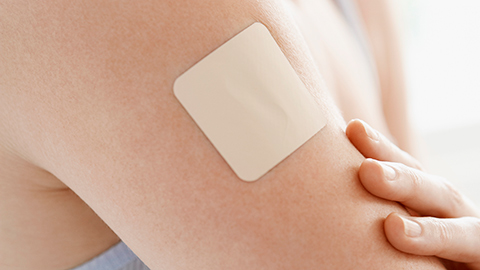
Sixty minutes into the session, a massage therapist discovers the client has a fentanyl patch—that they did not report on their intake form. Is the therapist at risk for exposure? What are some good practices regarding medicated patches for massage therapy clients? Listen on for more.
Resources: 
Pocket Pathology: abmp.com/abmp-pocket-pathology-app
NIDA. 2021, June 1. Fentanyl DrugFacts. Retrieved from https://www.drugabuse.gov/publications/drugfacts/fentanyl on 2022, January 3
Prausnitz, M. R., & Langer, R. (2008). Transdermal drug delivery. Nature biotechnology, 26(11), 1261-1268. https://doi.org/10.1038/nbt.1504


This podcast sponsored by:
About Anatomy Trains:
Anatomy Trains is a global leader in online anatomy education and also provides in-classroom certification programs forstructuralintegration in the US, Canada, Australia, Europe, Japan, and China, as well as fresh-tissue cadaverdissectionlabs and weekend courses. The work of Anatomy Trains originated with founder Tom Myers, who mapped the human body into 13 myofascial meridians in his original book, currently in itsfourthedition and translated into 12 languages. The principles of Anatomy Trains are used by osteopaths,physicaltherapists,bodyworkers,massagetherapists,personaltrainers,yoga,Pilates,Gyrotonics,and other body-minded manual therapists and movement professionals. Anatomy Trains inspires these practitioners to work with holistic anatomy in treating system-wide patterns to provide improved client outcomes in terms of structure and function.
Website:anatomytrains.com
Email:info@anatomytrains.com
Facebook:facebook.com/AnatomyTrains
Instagram: instagram.com/anatomytrainsofficial
0:00:00.0 Speaker 1: Ruth Warner's best-selling book, A Massage Therapist's Guide to Pathology, is a highly regarded comprehensive resource that sets the standard for pathology Education, written for massage therapy students and practitioners. This ground-breaking resource serves up a comprehensive review of the pathophysiology signs, symptoms and treatment of more than 500 diseases and disorders. Learn more at booksofdiscovery.com.
0:00:32.7 Speaker 2: Anatomy trains is delighted to announce a brand new dissection livestream specialty class in September 18th, Lumbopelvic stability, a one-day layered dissection with Anatomy Trains, author Tom Myers and master dissector Todd Garcia. The early bird price of $150 is held until September 10th. After September 10th, the price is $250. Come see the body's actual core for yourself. This course will be provided over Zoom webinar with multiple camera views, live chat and Q&A. Visit anatomytrains.com to sign up.
[music]
0:01:15.4 S1: Hi, and welcome to I HAVE A CLIENT WHO pathology conversations with Ruth Werner, the podcast where I will discuss your real life stories about clients with conditions that are perplexing or confusing. I am Ruth Werner, author of A Massage Therapist's Guide to Pathology, and I have spent decades studying, writing about and teaching about where massage therapy intersects with diseases and conditions that might limit our client's health. We almost always have something good to offer, even with our most challenged clients, but we need to figure out a way to do that safely, effectively and within our scope of practice, and sometimes, as we have all learned, that is harder than it looks.
0:02:01.0 S1: Welcome back to I HAVE A CLIENT WHO pathology conversations with Ruth Werner. This is my first episode of 2022, and I want to take a moment to wish everyone a healthy, hap=py, wonderful New Year. We're already off to a bit of a rocky start with the fires around Boulder and the mysteries of Omicron and snow storms threatening a huge part of the country, but let's just buckle up and take care of each other and we can make this the best year ever. Speaking of taking care of each other, today's episode deals with a massage therapist who wants to take great care of their client, but they ran into a situation they've never seen before, my thanks go to this therapist for being willing to share their story, which goes like this.
0:02:51.5 S1: I have done a quick search and have not found a clear answer, I have a client recently leave off a medication from the intake form. How I found out was I found their Fentanyl Transdermal Patch an hour into the session, does anyone know if these types of meds can be absorbed from one person to another? I get questions like this from time to time regarding transdermal medications, we like it when there's a patch, because we have a visual signal that something is happening here, sometimes clients apply things like hormones or other substances with a cream that doesn't have a patch, and that makes it even harder to deal with, especially if they haven't given us a heads-up on their intake form, and we'll get back to that in a bit.
0:03:43.0 S1: So it sounds like the scenario is that this massage therapist was working with a client, and an hour into the session, they found a fentanyl patch that the client had not disclosed, and now the therapist is worried about whether they might have absorbed some of this medicine. Well, here's a spoiler alert, the answer to that is probably not, but it's a good opportunity to talk a little bit about fentanyl and transdermal medications, plus about things we might do to avoid being put in the situation that this massage therapist had to deal with. We will start with a visit to NIDA, the National Institute on Drug Abuse, and they describe fentanyl in this way, quote Fentanyl is a powerful synthetic opioid that is similar to morphine, but is 50 to 100 times more potent, it is a prescription drug that is also made and used illegally like morphine, it is a medicine that is typically used to treat patients with severe pain, especially after surgery, it is also sometimes used to treat patients with chronic pain who are physically tolerant to other opioids, tolerance occurs when you need a higher and or more frequent amount of a drug to get the desired result, synthetic opioids, including Fentanyl are now among the most common drugs involved in drug overdose deaths in the United States.
0:05:13.5 S1: When prescribed by a doctor, Fentanyl can be given as a shot, a patch that is put on a person's skin, or as lozenges that are sucked, like cough drops. Right, so that's what the NIDA has to say about it. I can say from my own experience that when I had my gall bladder out a couple of years ago, fentanyl made the whole experience much less horrible, but I got it as a shot delivered via my IV, and as we see from the NIDA and today's contributor, it is also available as a patch that is applied to the skin. Patches to deliver medications are a relatively new phenomenon in modern health care. The first patch used in the United States was a drug called Scopolamine which was used to treat motion sickness in 1979, fentanyl in patch application was approved for chronic pain in 1990, and of course, now we have patches to deliver low doses of Nicotine, Estradiol, Testosterone, Lidocaine, Methylphenidate, that's Ritalin to you and me to treat ADHD and lots of others. The advantage of this way of taking in drugs is that they can be administered in slow doses over long periods, and they also skip the first pass route of metabolism in which the liver may filter out much of the drug before it reaches the general circulation, and that's what happens when we take medication orally.
0:06:47.0 S1: The mechanisms by which medications enter the bloodstream from the surface of the skin vary from drug to drug and can be influenced by the presence of other chemical enhancers. The biggest barrier is the stratum corneum, the mostly impermeable layer of the skin that helps us to be waterproof. In first generation approaches to transdermal delivery... Well, let me read to you from a fascinating paper on this topic, and of course the reference will be in our show notes. This paper says, the first generation approach to transdermal delivery is limited primarily by the barrier posed by the skin's outermost layer called stratum corneum. Closer examination of the stratum corneum barrier reveals a brick and mortar structure, where the bricks represent non-living corneocyte cells composed primarily of cross-linked keratin and the intercellular mortar is a mixture of lipids organized largely in bilayer, drug transport across the stratum corneum typically involves diffusion through the intercellular lipids via path that winds tortuously around the cornea sites where hydrophilic molecules travel through the lipid head group regions and lipophilic molecules travel through the lipid trails.
0:08:10.8 S1: This transport pathway is highly constrained by the structural and solubility requirements for solution and diffusion within stratum corneum lipid bilayers. Okay, in other words, this means drug molecules have to be a certain size to make it through this tortuous pathway, nowadays, we are exploring other ways to influence this process, but fentanyl is kind of old school and uses this first generation approach, drug patches are constructed in a specific way, from superficial to deep, they have four basic layers, the waterproof outer layer, which looks a lot like the outer layer of a typical bandage, then there's a layer that serves as the drug reservoir, then there's a semi-permeable layer that allows that drug to seep through at a pre-determined rate, and then there's an adhesive layer that makes the whole thing stick to the skin.
0:09:09.7 S1: Okay, so now we know a little bit about fentanyl, and we know a little bit about fentanyl patches, so let's apply this knowledge to our contributors situation, this client did not disclose that they were using a fentanyl patch, so the massage therapist found it incidentally mid-session or at 60 minutes in I'd say it was more likely to be toward the end of the session, we don't know why this client had a patch, but it's a safe guest that it was to deal with chronic pain, with some other things that you wanna know. Here are the some of the questions I would wanna ask, what is the nature of the pain that the patch is being used for, and does the client hope that massage therapy is gonna help them with that pain as well? How long has this particular patch been on and how often is a new one applied? What other medications is the client using to help manage their pain? And what side effects do they notice? For instance some patches caused a lot of skin irritation.
0:10:09.1 S1: Then I would want to adjust massage therapy to meet the needs of a client who is A, in pain, and B, using a heavy duty pain reliever, the guidelines I propose for massage therapy in the context of any kind of medicated patch is that it's a good idea to avoid this area for a margin of 2 to 4 inches, all the way around, and my concern is less about inadvertent exposure to the drug, I'll get back to that in a moment, but more about changing the rate of the drugs release, which could alter uptake and then alter the effectiveness of the prescription, even if we work through a sheet or if we work in that area with gloves on to minimize the risk of our own exposure, manipulating the tissue around where the patch is adhered will alter the shape of the skin and the relationship of all those stratum corneum skin cells, pressing, lifting, stretching the skin could have an unintended effect on how the drug works, and that is obviously not desirable.
0:11:14.3 S1: Now, let's look at the issue of the massage therapist's exposure. The exposed layer of the patch is completely impermeable, so it's basically not an issue, the edges around the patch might allow for a small amount of seepage of the drug, which is one reason... I think it's a good idea to avoid the area, but how vulnerable are massage therapists to be in-dosed in this way? Not very, for a few different reasons. First, very little, if any of the drug is likely to be exuded from edges around the patch, second, it takes prolonged exposure for the drug to enter the bloodstream from the skin, and we wash our hands between each client, so our exposure isn't gonna go for more than a couple of hours, probably at the most, and thirdly, the stratum corneum is the main barrier that prevents drugs from entering the bloodstream, and this layer is especially thick on our hands, so between these factors, the massage therapist's risk of being exposed to fentanyl are extremely low. Not quite zero. And the best way to move that needle all the way to zero is to know ahead of time that the client has a patch that is delivering a synthetic opioid directly into their blood stream.
0:12:38.1 S1: And if our client doesn't let us know ahead of time, well, that creates a problem, doesn't it? Possibly some people just don't consider that a skin patch or a medicated cream is in the same category as oral drugs, and so they don't put it on their intake form, but patches are increasing in popularity and in usage, so it's just a good idea to include a question about these interventions on our intake forms. I wanna thank our massage therapist who contributed today's story, again, this kind of thing happens a lot, and I'm grateful to be able to use this situation to help others feel safer and more confident about working with their clients who use medicated patches.
0:13:20.8 S1: Hey everybody, thanks for listening to I HAVE A CLIENT WHO pathology conversations with Ruth Werner. Remember, you can send me your I HAVE A CLIENT WHO's stories to Ihaveaclientwhoatabmp.com. That's I have a client who, all one word, all lowercase, at abmp.com. I can't wait to see what you send me and I'll see you next time.
[music]